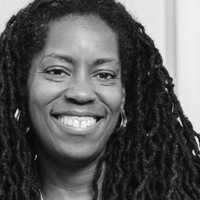Interest | Nichole Pinkard
"I think it’s hard to look at interest for underrepresented youth in coding or making, because they’re not surrounded by opportunities to engage in those things in the same way that they are surrounded with sports."

2018 Interview Highlights:
How do you conceptualize interest when you’re designing your research?
I don’t see myself as an interest researcher. I see myself as an ecosystem designer. I look at interest by looking at how kids choose to spend their time. I think it’s hard to look at interest for underrepresented youth in coding or making, because they’re not surrounded by opportunities to engage in those things in the same way that they are surrounded with sports. Even if a kid on the South Side or West Side of Chicago doesn’t have an interest in playing basketball, they’re going to constantly come into contact with basketball and have to make a decision to play, not to play, just play a little bit, or go deep in it. Every kid has made a decision around sports because it’s in their environment. They understand the social capital value of it. They see it on TV, they see it in their neighborhood, they see it at school. So if we want to look at STEM in that way, then we can’t say they don’t have an interest in STEM if they don’t have opportunities to come into contact with STEM learning opportunities besides the tech class at school. So I actually don’t like to talk a lot about whether these kids have interest in this, because I feel like we haven’t given them the opportunity to discover their interest.
How do you see identity, motivation, and attitudes as being connected? Do you make a distinction between interest and the other concepts?
I see motivation as also communal, and a lot of it has to do with social capital value. We engage in things that we believe in. So I think interest and motivation come before identity. I think motivation can be extrinsic or intrinsic, the same way interest can be intrinsic and extrinsic. And I think for youth often there are some areas that a community, just by nature, values more. It’s subconscious that you participate in those. I think we have to think differentially in how we support underrepresented youth and girls, particularly in STEM, to be aware that they have to develop the muscles to work against the community values in terms of how they view their race or their gender in participating in STEM.
Do you measure interest in the work you’re doing?
Yes, in terms of participation. What we’ve been focused on is the work of my colleague Ugochi Jones. And one of the “ahas” that she brought to our work was the concept of movement—that we can’t even look at outcomes until we look at whether we have gotten the forms of participation that we need. So we now look at movement, but we also want to understand the choices that kids have. Not every kid starts out with the same set of options. You have to understand how kids are engaging in their movement, what the opportunity map is against, and what they’re operating for. I would guarantee that if you show most communities their opportunity maps, particularly in more middle-resource places, you will see a lot more programming intentionally taking place.
What led you to study interest in your research?
I was trying to understand why I, as a young African American girl from Kansas City, Kansas, ended up exploring and really becoming passionate about computer science. Did it just happen, or was there something in the environment that led that to happen? If it was environmental factors, I believe you can learn from those and create environments that support others. No one told me I needed to be engaged in computer science, I just was fortunate to have opportunities both in school and out of school, back in the early 1980s, to engage with technology. For me it was just a place to play, and opportunities kept being put in front of me that led over time to engagement, so I developed an interest and a passion for it.
I’m interested in creating other spaces, not just one or two examples, but 10, 12, 20, to show that you can create environments that are reliably producing underrepresented youth who are engaged and motivated in STEM. We can all show one or two kids in our work who are the jewels. But we have to be able to show more than one or two, and that to me shows that there’s an ecosystem at work and that’s what I’m trying to understand.